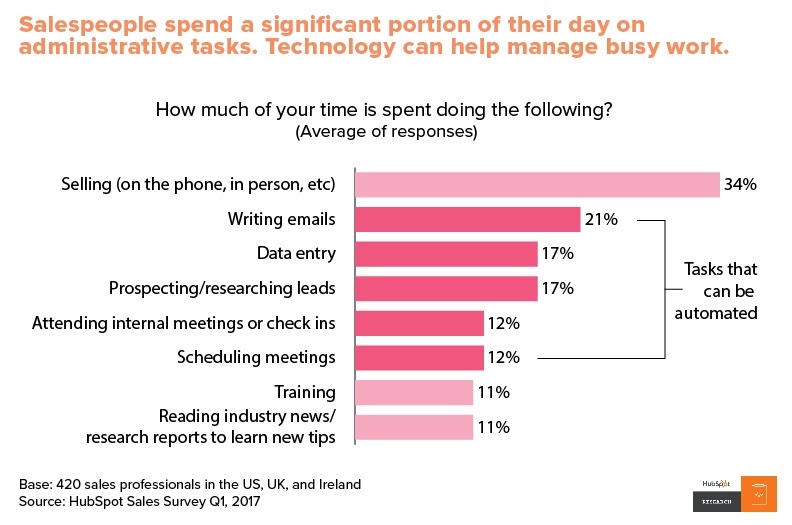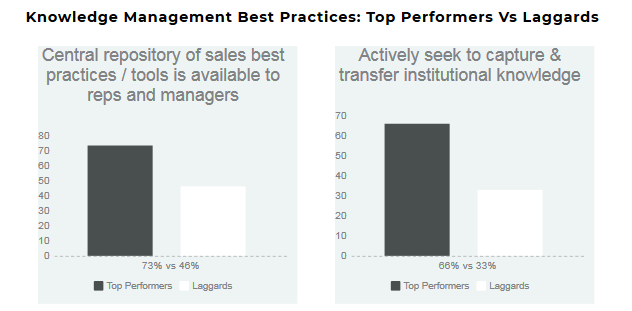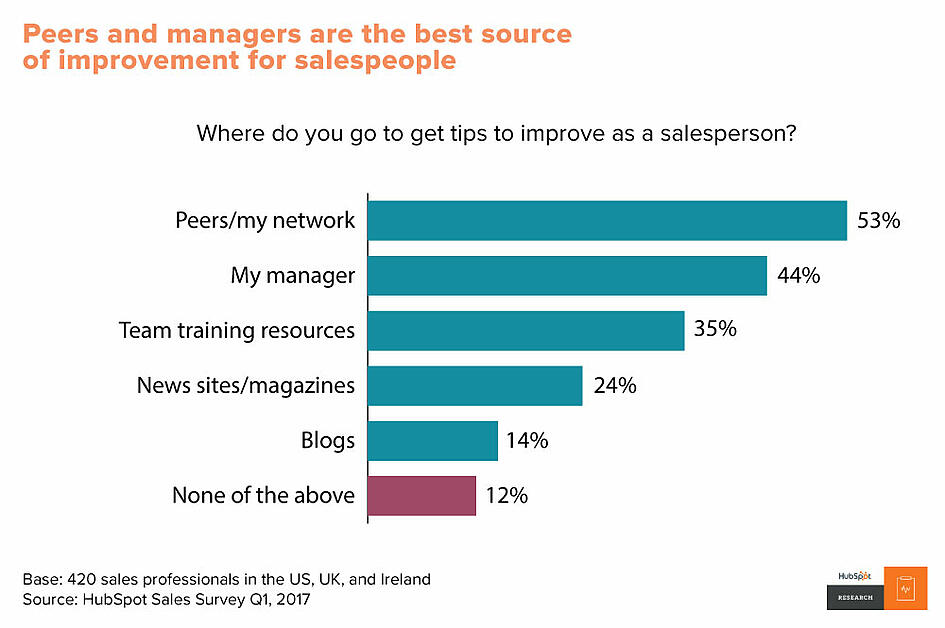Whether you have an entire sales department or a small sales team, one thing is certain:
Sooner or later, your best salespeople will leave.
For many industries, turnover rates have been growing steadily and sales is no exception to this rule.
According to a recent report by the Bridge Group, the average sales rep tenure is 1.5 years. At the same time, the report reveals, it typically takes 3.2 months for a new sales rep to get up to speed.
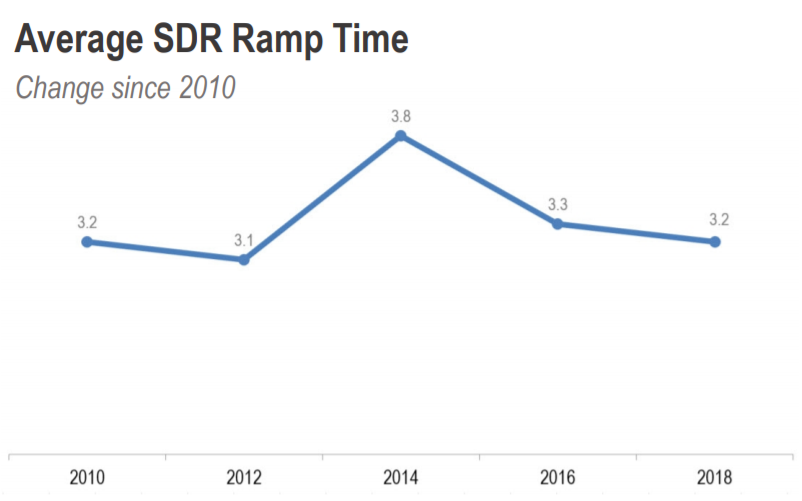
Essentially, this means that your salespeople are working at peak productivity for 15 months only. Then, you have to replace them which costs 1.5 – 2x their annual salary.
In other words, companies spend an enormous amount of money to train sales professionals that leave in about a year. And, when these employees leave, they usually take their knowledge and expertise with them.
Every time a salesperson leaves, sales knowledge is leaking from your organization.
Tweet this quote
To make matters worse, the salespeople that do stay with your company are struggling to find the knowledge, information, and resources they need to be efficient.
According to Docurated, sales reps waste a staggering 26 hours per month finding, editing and managing content across a number of locations. At the same time, only 14% are confident that they use the most up-to-date content.
Additionally, Xant reports that the average salesperson spends the majority of their time on administrative tasks that can be automated. Productive sales activities such as client meetings and prospecting fall to the backburner.
It’s a knowledge management problem
High turnover paired with an overwhelming amount of administrative tasks creates a serious challenge to sales teams. New team members come and go quickly and go through a tedious onboarding process. Seasoned professionals waste time in manual work.
The solution to both of these problems is Knowledge Management (KM):
- With the appropriate KM technology in place, sales reps can access the information they need when they need it.
- A KM solution for internal communication and training can speed up your sales onboarding and cut your employee replacement costs.
- A KM solution for customer profiling can help reduce manual work and create a seamless hand-off process between Marketing, Sales and Customer Service.
The list goes on and on, so let’s have a closer look at how you can use the various Knowledge Management solutions in practice.
How to use knowledge management to improve the flow of your sales knowledge
Document your sales process
If you don’t have a sales process in place, this may be a great time to document your best practices and create one.
A study by HBR revealed that companies with a formal sales process experience 28% higher revenue growth, compared to companies that don’t.
Another study by the Aberdeen Group found that companies with above-average sales performance have a central repository of sales best practices and tools compared to laggard companies (73% vs 46%) as well as look to capture knowledge from seasoned sales professionals and transfer said knowledge to newer employees (66% vs 38%).
Then, there is the fact that the customer journey is very fragmented today and the sales pipeline is no longer linear — it branches in dozens of directions. So, if a sales rep has just joined your organization, there will be a lot of information to take in. Studies have shown that more than ⅔ of this information will be forgotten after the initial onboarding.
Instead of relying solely on onboarding, you can continuously capture, store and update the knowledge about your sales process in a knowledge base (KB), corporate wiki, or some other document management system.
The biggest advantage of this approach is that your sales reps will always have the most up-to-date information at their fingertips.
Your document management system should serve as a centralized, searchable knowledge hub that can make it easy for your sales team to:
- Find relevant case studies, blog posts, and customer references.
- Capture information about what has or hasn’t worked in the past and associated lessons learned.
- Store information about how to use specific sales tools and technologies.
- Contain onboarding documents that make it easy for new hires to get up to speed.
Conduct formal training (onboarding)
Having a document management system is a great way to reduce the need for coaching and to pre-answer some of the questions your sales reps will have. This doesn’t mean you can skip formal training, though.
According to Salesforce, effective training is directly tied to sales performance: 80% of high-performing sales teams have very good training processes in place. Also, Accenture reports, companies receive an average ROI of 353% for each dollar spent on training.
To publish a formal training and make it available to your sales team, you can use a KM tool such as a Learning Management System (LMS).
This is what digital marketing performance agency iProspect did. The company used an LMS to launch a blended learning program that enabled the Client Services team to become more proactive and add more value to customers. The approach combined live and online classes with on-demand videos, scenarios, quizzes, and competitive leaderboards to help participants implement their knowledge immediately in the day-to-day.
After the training program was implemented, iProspect used the data insights from their LMS platform to tailor the content to the needs of their staff. The project brought a 22:1 ROI, enabling the company to expand its portfolio of clients.
Enable continuous training (reboarding)
Continuous training or reboarding is about helping your sales team stay on top of the business and the most effective sales tactics.
Reboarding is worth considering because it can directly double the net sales per employee.

Besides, as Jim Ninivaggi pointed out in an interview for Brainshark, ongoing sales training can also reduce your employee turnover rates. As a founder and leader of Sirius Decisions’ sales enablement research practice, Jim has published hundreds of reports, research briefs and blog posts on the subject:
If you look at turnover rates for organizations, typically 12 to 36 months is where you are going to see the highest turnover rate, and a lot of that is voluntary. (It’s) reps saying ‘I am not going to be successful here,’
Tweet this quote
So, how can you implement continuous training? Here are a few practical tips to get you started:
- Identify gaps in knowledge. Look at the reports from your CRM — What do sales rep need to improve the most? Look at the searches in your internal KB — What information are they looking for but not finding?
- Create “snackable” content. Sales reps are notoriously busy so it’s best to present new information in small pieces.
- Gamify the experience. You can introduce a scoring system to create friendly competition and stimulate sales reps to learn on an ongoing basis.
SevOne, one of the world’s largest Communication Service Providers (CSPs), appointed MindTickle to create bite-sized videos that are easily accessible and available on-demand by Sales for ongoing learning.
Additionally, MindTickle gamified the process to increase engagement and ensure high usage of their platform by SevOne’s sales team. When an employee watches a video, they receive points. The employee’s score is increased together with the entire team’s score. Every week, a report is emailed to everyone, highlighting the top-performing individuals and sales teams. This way, there is competition both between individuals and between teams.
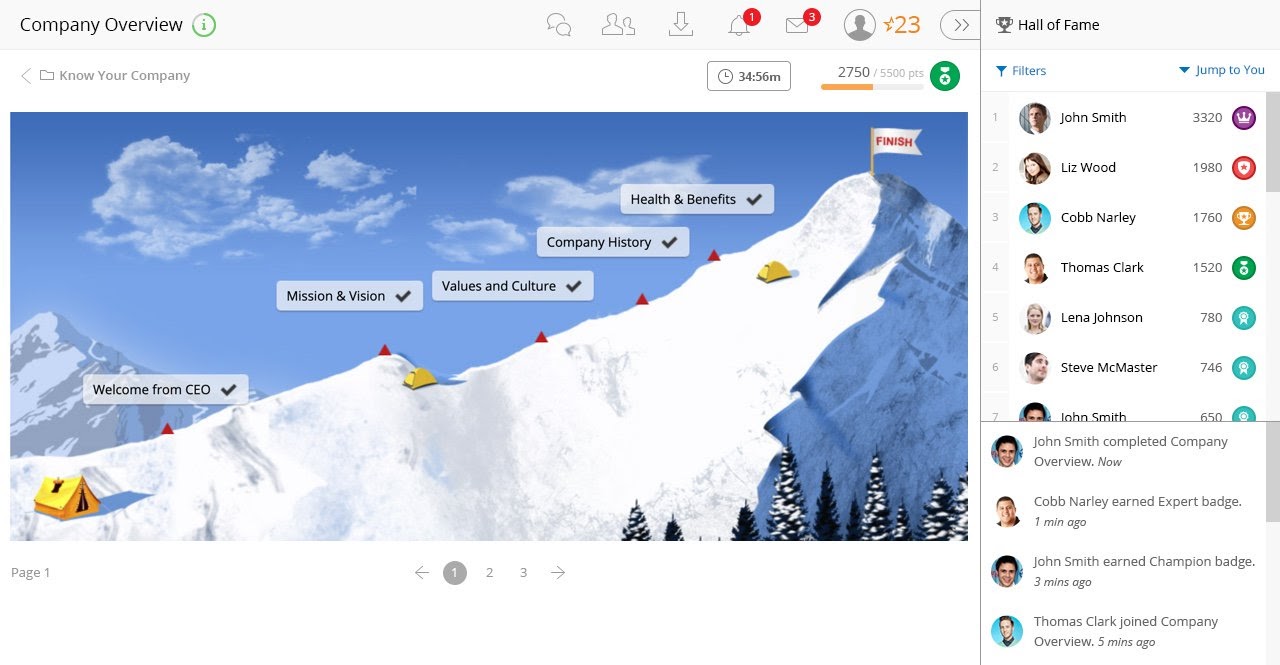
Create a knowledge-sharing culture
Most SaaS companies evolve relatively fast which means that sales professionals need to constantly refresh their knowledge and adjust their messaging. To speed up this process for the entire team, companies have to make continuous knowledge sharing a habit.
Besides, knowledge sharing can also improve your overall business operations — it can reduce the friction between Marketing and Sales and enable seamless handoff between Sales and Customer Service.
Here are a few of the ways you can enable knowledge sharing in your sales team:
- Record all webinars, emails, demos and other assets that your sales team members develop
- Share information and best practices from the field using bite-sized videos or blogs
- Create incentives for the most active employees and show them metrics that prove knowledge sharing is helping them close more deals faster
- Have less experienced reps shadow live calls
- Pair new members of your team with seasoned professionals (apprenticeship)
- Conduct knowledge sharing workshops
If you’re wondering where to start with sales knowledge sharing, in-person workshops and coaching may be the best option because salespeople prefer to learn from their peers and managers.
Loopio is one of the companies that prove knowledge sharing doesn’t require a lot of effort. The sales team simply meets every week for their pipe strategy sessions. This is an informal event where each rep shares challenging situations or objections they come up against. Then, the entire team brainstorms and shares their suggestions about how to move the deal forward. Although sales professionals typically compete with each other, these workshops have been successful because everyone gets help when they get stuck.
Capitalize on customer knowledge
By improving your training and onboarding, you equip your salespeople with the general knowledge they need to close more deals. But, in a SaaS company, you also need to direct your sales efforts to the right customers.

Should you be attracting more customers?
Should you be upselling existing customers?
What kind of customers should you be looking for?
These are just some of the (potentially) million-dollar questions that your SaaS metrics can answer. Armed with such customer knowledge, you can adjust your sales strategy and achieve sustainable growth.
To put this into perspective, let’s look at an example.
Meditopia, a mental wellness platform, had tons of customer data but it was scattered across various platforms. So, the team couldn’t actually capitalize on it.
They realized that they needed to bring this data together to make sure they were putting their efforts into targeting the people who are the best fit. Using Chartmogul, Mediatopia began tracking key metrics such as active users, subscriber growth, MRR growth, daily conversion rates, free trials, people who were about to churn in the next 7/14 days.
Analyzing this data helped the team understand what drives conversions and churn and where they should focus their efforts. As a result, they grew their active subscribers by 500%.
Putting it all together
Sales reps tend to switch jobs often, taking away their knowledge and expertise. The ones that remain at your company often lack the necessary training and struggle to find relevant information.
The good news is that you can easily retain your sales knowledge and capitalize on it with knowledge management solutions.
Using a knowledge base, you can quickly document your sales process and best practices. A learning management system can help improve your sales training and weekly workshops can stimulate knowledge sharing. Last but not least, with an integrated analytics tool, you can bring your customer data in one place and make it available to everyone who needs it — Sales, Marketing, Customer Service, you name it.
About the Author
Emil Hajric is the founder and CEO of Helpjuice as well as author of Knowledge Management: A Theoretical and Practical Guide for Knowledge Management in Your Organization. Helpjuice enables you to easily create a comprehensive knowledge base that can enhance business productivity by improving knowledge sharing and collaboration within an organization.

